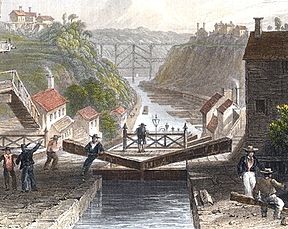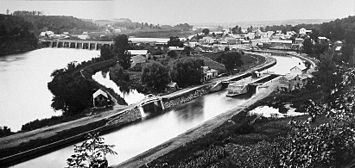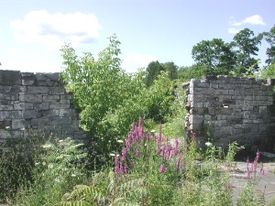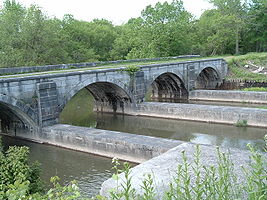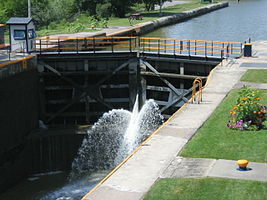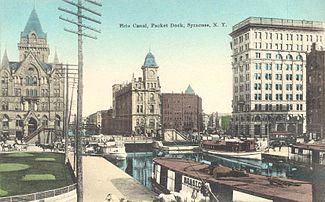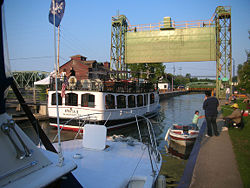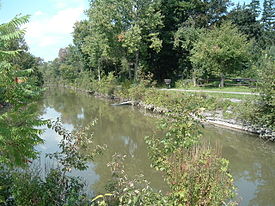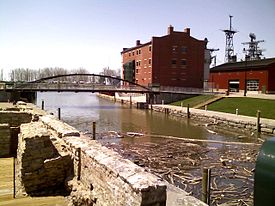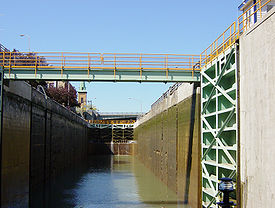- Erie Canal
-
Erie Canal at Lockport, New York in 1839 Original owner New York State Principal engineer Benjamin Wright Other engineer(s) Canvass White Construction began July 4, 1817 (at Rome, New York) Date of first use May 17, 1821 Date completed October 26, 1825 Branch of New York State Canal System The Erie Canal is a waterway in New York that runs about 363 miles (584 km) from Albany, New York, on the Hudson River to Buffalo, New York, at Lake Erie, completing a navigable water route from the Atlantic Ocean to the Great Lakes. The canal contains 36 locks and encompasses a total elevation differential of around 565 ft. (169 m). First proposed in 1807, it was under construction from 1817 to 1825 and officially opened[1] on October 26, 1825.
It was the first transportation system between the eastern seaboard (New York City) and the western interior (Great Lakes) of the United States that did not require portage, was faster than carts pulled by draft animals, and cut transport costs by about 95%. The canal fostered a population surge in western New York state, opened regions farther west to settlement, and helped New York City become the chief U.S. port. It was enlarged between 1834 and 1862. In 1918, the enlarged canal was replaced by the larger New York State Barge Canal.
Today, it is part of the New York State Canal System. In 2000, the United States Congress designated the Erie Canalway National Heritage Corridor[2] to recognize the national significance of the canal system as the most successful and influential human-built waterway and one of the most important works of civil engineering and construction in North America.[3] Mainly used by recreational watercraft in the recent past, the canal saw an upsurge in commercial traffic in 2008.[4]
Contents
Background
From the first days of the expansion of the English colonies from the coast of North America into the heartland of the continent, a recurring problem was that of transportation between the coastal ports and the interior. Close to the seacoast, rivers often provided adequate waterways, but the presence of the Appalachian Mountains, a few hundred miles inland, presented a great challenge. Passengers and freight had to travel overland, a journey made more difficult by the rough condition of the roads. That the principal exportable product of the Ohio Valley was grain did not help matters, as grain was a high-volume, low-priced commodity, frequently not worth the cost of transporting it to far-away population centers (this was a factor leading to the Whiskey Rebellion). In the 18th and early 19th centuries, it became clear to coastal residents that the city or state that succeeded in developing a cheap, reliable route to the West would enjoy economic success, and that the port at the seaward end of such a route would see business increase greatly.[5] In time, projects were devised in Virginia, Maryland, Pennsylvania, and elsewhere.
Proposal and logistics
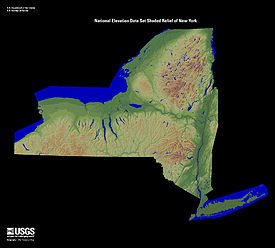 The Mohawk Valley, running east and west, cuts a natural pathway between the Catskill Mountains to the south and the Adirondack Mountains to the north
The Mohawk Valley, running east and west, cuts a natural pathway between the Catskill Mountains to the south and the Adirondack Mountains to the north
The extraordinary success of the Bridgewater Canal in Britain, completed in 1761, led to a frenzy of canal building in England. The colonial idea of a canal or artificially improved waterway to tie the east coast to the new western settlements was in the air: in 1724, New York provincial official Cadwallader Colden made a passing reference (in a report on fur trading) to improving the natural waterways of western New York. George Washington led a serious effort to turn the Potomac River into a navigable link to the west, sinking substantial energy and capital into the Patowmack Canal from 1785 until his death fourteen years later. Christopher Colles, who was familiar with the Bridgewater Canal, surveyed the Mohawk valley and made a presentation to the New York state legislature in 1784 proposing a canal from Lake Ontario. The proposal drew attention and some action, but ultimately came to nothing.
Gouverneur Morris and Elkanah Watson were other early proponents of a canal along the Mohawk. Their efforts led to creation of the Western Inland Lock Navigation Company, which took the first steps to improve navigation on the Mohawk, but the company proved that private financing was inadequate. In 1798, the Niagara Canal Company was incorporated.
The advocate who finally got the canal built was entrepreneur Jesse Hawley. He envisioned growing huge quantities of grain on the Western New York plains, then largely unsettled, for sale on the Eastern Seaboard. He went bankrupt, however, trying to ship it to the coast. While in Canandaigua debtors' prison, he started pressing for the construction of a canal along the 90-mile-long Mohawk River and valley. He had strong support from Joseph Ellicott, agent for the Holland Land Company in Batavia. Ellicott realized that a canal would add immense value to the land he was selling in the western part of the state. Ellicott later became the first canal commissioner.
The Mohawk River, a tributary of the Hudson, runs in a glacial meltwater channel across the Appalachians in New York state, separating them into the Catskills and Adirondacks. The Mohawk Valley was the only cut across the Appalachians north of Alabama, and led almost directly from the Hudson River in the east to Lake Ontario and Lake Erie in the west. From there, much of the interior and many settlements would be accessible by the Great Lakes and related rivers.
The problem was that the land rises about 600 feet (180 m) from the Hudson to Lake Erie. Locks at the time could handle up to 12 feet (3.7 m), so at least fifty locks would be required along the 360 miles (580 km) canal. Such a canal would cost a fortune even today; in 1800 the expense was barely imaginable. President Jefferson called it "a little short of madness" and rejected it. Nevertheless, Hawley managed to interest New York Governor DeWitt Clinton. There was much opposition, and the project was scorned as "Clinton's Folly," or "Clinton's Ditch." But in 1817 Clinton got the legislature to appropriate $7 million for construction.
The original canal was 363 miles (584 km) long, from Albany on the Hudson to Buffalo on Lake Erie. The channel was a cut 40 feet (12 m) wide and 4 feet (1.2 m) deep, with removed soil piled on the downhill side to form a walkway called the towpath. Canal boats, up to 3.5 feet (1.1 m) in draft, were pulled by horses and mules on the towpath. There was only one towpath, generally on the north side of the ditch. When canal boats met, the boat with right-of-way steered to the towpath side of the canal. The other boat steered toward the berm or heelpath side of the canal. The driver or "hoggee" (pronounced HO-gee) of the privileged boat brought his team to the canalside edge of the towpath while the hoggee of the other boat moved to the outside of the towpath and stopped his team. His towline would go slack, fall into the water and sink to the bottom while his boat continued on by momentum. The privileged boat's team would step over the other boat's towline, and then their boat would pass over the sunken towline without stopping. Once clear, the other boat's team would continue on its way.
The Erie Canal started construction in 1817 and was completed 8 years later. It was the first commercial link between New York East and the West. The Erie Canal cost $7 million to construct and was acclaimed as one the greatest engineering marvels in the world. It united the country and help NYC become the financial state it is. In 1809 New York delegation went to Washington DC to propose a funding for the Canal. Thomas Jefferson said to come back in a 100 years because the project would bankrupt the nation let alone the state. Yet, Dewitt who was head of the committee who later became governor did not listen. There was a lot of political opposition, but in 1817 the canal bill was passed.
Reality hit when they realized that they had to build through limestone and mountains, battle water, and deal with other environmental factors. Malaria, borne by mosquitos killed over 1000 men who were working on the canal in a single season. The canal was built using one of the most engineering technology marvels from Holland. In 1823, the building reached Niagara escarpment and faced with the problem on how to flow water up. With the use of technology it built 5 locks that would fill the water and move the water and boat 12 ft each time until it reached the Erie Canal. The sides of the cut were lined with stone set in clay, and the bottom was also lined with clay. The stonework required hundreds of German masons, who later built many of New York's famous buildings.
All of the labor on the canal depended upon either human and animal power or the force of water. Engineering techniques developed during the building. To redirect water, the builders utilized the aqueduct, a structure for transporting water which was originally developed by the Ancient Romans. One aqueduct was 950 foot long to span 800 feet of river. As the canal progressed, the crews and engineers working on the project developed expertise and became a skilled labor force. The building of the locks at the Niagara escarpment also required specialized engineering skills to dig through solid rock and build a 3-mile corridor. To move earth, animals pulled a new type of Slip Scraper, akin to a bulldozer.
Construction
Construction began July 4, 1817, at Rome, New York. The first 15 miles (24 km), from Rome to Utica, opened in 1819. At that rate the canal would not be finished for thirty years. The main problems were felling trees to clear a path through virgin forest and moving excavated soil, both of which took longer than expected, but the builders solved these problems. To fell a tree, they threw rope over the top branches and winched it down. They pulled out the stumps with an innovative stump puller. A pair of huge wheels were set loose on an axle. A large wheel, barely smaller than the others, was fixed to the center of the axle. A chain was wrapped around the axle and hooked to the stump. A rope was wrapped around the center wheel and hooked to a team of oxen. The mechanical advantage (torque) obtained ripped the stumps out of the soil. Soil to be moved was shoveled into large wheelbarrows that were dumped into mule-pulled carts.
A three-man team with mules could build a mile in a year. The remaining problem was finding enough labor, and increased immigration helped fill the need. The men who planned and oversaw construction were novices, both as surveyors and as engineers. There were no civil engineers in the United States. James Geddes and Benjamin Wright, who laid out the route, were judges whose experience in surveying was in settling boundary disputes. Geddes had only used a surveying instrument for a few hours.[citation needed] Canvass White was a 27-year-old amateur engineer who persuaded Clinton to let him go to Britain at his own expense to study the canal system there. Nathan Roberts was a mathematics teacher and land speculator. Yet these men "carried the Erie Canal up the Niagara escarpment at Lockport, maneuvered it onto a towering embankment to cross over Irondequoit Creek, spanned the Genesee River on an awesome aqueduct, and carved a route for it out of the solid rock between Little Falls and Schenectady—and all of those venturesome designs worked precisely as planned." (Bernstein, p. 381) Many of the laborers working on the canal were Scots Irish, who had recently come to the United States as a group of about 5,000 from Northern Ireland, most of whom were Protestants and wealthy enough to pay for this caravan.
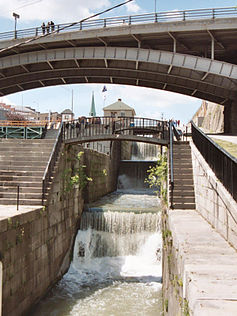 An original five step lock structure crossing the Niagara Escarpment at Lockport, now without gates and used as a cascade for excess water.
An original five step lock structure crossing the Niagara Escarpment at Lockport, now without gates and used as a cascade for excess water.
Construction continued at an increased rate as new workers arrived. When the canal reached Montezuma Marsh (at the outlet of Cayuga Lake west of Syracuse), over 1,000 workers died of swamp fever and construction stopped. Work continued on the downhill side towards the Hudson, and when the marsh froze in winter, the crews worked to complete the section across the swamps.
The middle section from Utica to Salina (Syracuse) was completed in 1820 and traffic on that section started up immediately. The eastern section, 250 miles (400 km) from Brockport to Albany, opened on September 10, 1823 to great fanfare.
The Champlain Canal, a 64 miles (103 km) north-south route from Watervliet on the Hudson to Lake Champlain, opened on the same date.
In 1824, before the canal was completed, a detailed Pocket Guide for the Tourist and Traveler, Along the Line of the Canals, and the Interior Commerce of the State of New York, was published for the benefit of travelers and land speculators — possibly America's first tour guide.
After Montezuma Marsh, the next obstacle was crossing the Niagara Escarpment, an 80-foot (24 m) wall of hard dolomitic limestone, to rise to the level of Lake Erie. The route followed the channel of a creek that had cut a ravine steeply down the escarpment, with two sets of five locks in a series, giving rise to the community of Lockport. These 12-foot (3.7 m) lift-locks had a total lift of 60 feet (18 m), exiting into a deeply cut channel. The final leg had to be cut 30 feet (9.1 m) through another limestone layer, the Onondaga ridge. Much of that section was blasted with black powder. The inexperience of the crews often led to accidents, and sometimes rocks falling on nearby homes.
Two villages competed to be the terminus: Black Rock, on the Niagara River, and Buffalo, at the eastern tip of Lake Erie. Buffalo expended great energy to widen and deepen Buffalo Creek to make it navigable and to create a harbor at its mouth. Buffalo won over Black Rock, and grew into a large city, encompassing its former competitor.
Work was completed on October 26, 1825. The event was marked by a statewide "Grand Celebration," culminating in successive cannon shots along the length of the canal and the Hudson, a 90-minute cannonade from Buffalo to New York City. A flotilla of boats, led by Governor Dewitt Clinton aboard the Seneca Chief, sailed from Buffalo to New York City in ten days. Clinton then ceremonially poured Lake Erie water into New York Harbor to mark the "Wedding of the Waters." On its return trip, the Seneca Chief brought a keg of Atlantic Ocean water back to Buffalo to be poured into Lake Erie by Buffalo's Judge Samuel Wilkeson, who would later become mayor.
Route
The canal began on the west side of the Hudson River at Albany, and ran north to Watervliet, where the Champlain Canal branched off. At Cohoes, it climbed the escarpment on the west side of the Hudson River and then turned west along the south shore of the Mohawk River, crossing to the north side at Crescent and again to the south at Rexford. The canal continued west near the south shore of the Mohawk River all the way to Rome, where the Mohawk turns north.
At Rome, the canal continued west parallel to Wood Creek, which flows westward into Oneida Lake, and turned southwest and west cross-country to avoid the lake. From Canastota west, it ran roughly along the north (lower) edge of the Onondaga Escarpment, passing through Syracuse and Rochester. Before reaching Rochester, the canal uses a series of natural ridges to cross the deep valley of Irondequoit Creek (a preglacial course of the Genesee River). At Lockport the canal turned southwest to rise to the top of the Niagara Escarpment, using the ravine of Eighteenmile Creek. The canal continued south-southwest to Pendleton, where it turned west and southwest, mainly using the channel of Tonawanda Creek. From Tonawanda south toward Buffalo, it ran just east of the Niagara River, where it reached its "Western Terminus" at Little Buffalo Creek (later it became the Commercial Slip), which discharged into the Buffalo River just above its confluence with Lake Erie. With Buffalo's recent re-watering of the Commercial Slip, a water route from the eastern terminus at Albany to the western terminus at Buffalo is once again open.
The Erie made use of the favorable conditions of New York's unique topography providing that area with the only break in the Appalachians range south of the St. Lawrence River. A major feature of New York is that the Hudson River below Glens Falls follows a valley formed by geologic forces, not erosion. The Hudson is tidal to Troy and Albany is west of the Appalachians. It allowed for east-west navigation from the coast to the Great Lakes within US territory.[6] The canal system thus gave New York State a competitive advantage, helped New York City develop as an international trade center, and allowed Buffalo to grow from just 200 settlers in 1820 to more than 18,000 people by 1840. The port of New York became essentially the Atlantic home port for all of the Midwest. It was because of this vital and critical connection that New York State would become known as the great "Empire State."
Enlargements and improvements
Derelict aqueduct over Nine Mile Creek north of Camillus, New York built in 1841 and abandoned c. 1918; one of 32 aqueducts on the Erie Canal, it has since been restored.
Problems developed but were quickly solved. Leaks developed along the entire length of the canal, but these were sealed with a newly invented cement that hardened underwater (hydraulic cement). Erosion on the clay bottom proved to be a problem and the speed was limited to 4 mph (6 km/h).
The original design planned for an annual tonnage of 1.5 million tons (1.36 million metric tons), but this was exceeded immediately. An ambitious program to improve the canal began in 1834. During this massive series of construction projects, known as the First Enlargement, the canal was widened to 70 feet (21 m) and deepened to 7 feet (2.1 m). Locks were widened and/or rebuilt in new locations, and many new aqueducts were constructed. The canal was straightened and slightly re-routed in some stretches, resulting in the abandonment of short segments of the original 1825 canal. The First Enlargement was completed in 1862, with further minor enlargements in later decades.
Today, the reconfiguration of the canal created during the First Enlargement is commonly referred to as the Improved Erie Canal or the Old Erie Canal, to distinguish it from the canal's modern-day course. Existing remains of the 1825 canal abandoned during the Enlargement are sometimes referred to today as Clinton's Ditch (which was also the popular nickname for the entire Erie Canal project during its original 1817-1825 construction).
Additional feeder canals soon extended the Erie Canal into a system. These included the Cayuga-Seneca Canal south to the Finger Lakes, the Oswego Canal from Three Rivers north to Lake Ontario at Oswego, and the Champlain Canal from Troy north to Lake Champlain. From 1833 to 1877, the short Crooked Lake Canal connected Keuka Lake and Seneca Lake. The Chemung Canal connected the south end of Seneca Lake to Elmira in 1833, and was an important route for Pennsylvania coal and timber into the canal system. The Chenango Canal in 1836 connected the Erie Canal at Utica to Binghamton and caused a business boom in the Chenango River valley. The Chenango and Chemung canals linked the Erie with the Susquehanna River system. The Black River Canal connected the Black River to the Erie Canal at Rome and remained in operation until the 1920s. The Genesee Valley Canal was run along the Genesee River to connect with the Allegheny River at Olean, but the Allegheny section, which would have connected to the Ohio and Mississippi rivers, was never built. The Genesee Valley Canal was later abandoned and became the route of the Genesee Valley Canal Railroad.
In 1903, the New York state legislature authorized construction of the New York State Barge Canal as the "Improvement of the Erie, the Oswego, the Champlain, and the Cayuga and Seneca Canals".[7] In 1905, construction of the Barge Canal began, which was completed in 1918, at a cost of $96.7 million.[8] Freight traffic reached a total of 5.2 million short tons (4.7 million metric tons) by 1951, before declining in the face of combined rail and truck competition.
Competition
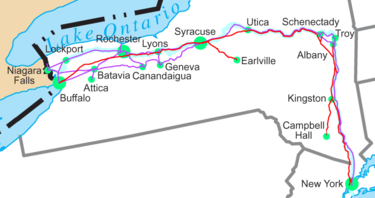 Map of the "Water Level Routes" of the New York Central Railroad (purple), West Shore Railroad (red) and Erie Canal (blue).
Map of the "Water Level Routes" of the New York Central Railroad (purple), West Shore Railroad (red) and Erie Canal (blue).
As the canal brought travelers to New York City, it took business away from other ports such as Philadelphia, Pennsylvania, and Baltimore, Maryland. Those cities and their states chartered projects to compete with the Erie Canal. In Pennsylvania, the Main Line of Public Works was a combined canal and railroad running west from Philadelphia to Pittsburgh on the Ohio River, opened in 1834. In Maryland, the Baltimore and Ohio Railroad ran west to Wheeling, West Virginia, also on the Ohio River, and was completed in 1853.
Other competition was more direct. The Mohawk and Hudson Railroad opened in 1837, providing a bypass to the slowest part of the canal between Albany and Schenectady. Other railroads were soon chartered and built to continue the line west to Buffalo, and in 1842 a continuous line (which later became the New York Central Railroad and its Auburn Road in 1853) was open the whole way to Buffalo. As the railroad served the same general route as the canal, but provided for faster travel, passengers soon switched to it. However as late as 1852, the canal carried thirteen times more freight tonnage than all the railroads in New York state combined; it continued to compete well with the railroads through 1882, when tolls were abolished.
The New York, West Shore and Buffalo Railway was completed in 1884, as a route running closely parallel to both the canal and the New York Central Railroad. However, it went bankrupt and was acquired the next year by the New York Central.
Impact
The Erie Canal made an immense contribution to the wealth and importance of New York City, Buffalo, and New York State. Its impact went much further, increasing trade throughout the nation by opening eastern and overseas markets to Midwestern farm products and by enabling migration to the West. New ethnic Irish communities formed in some towns along its route after completion, as Irish immigrants were a large portion of the construction labor force. Earth extracted from the canal was transported to the New York city area and used as landfill in New York and New Jersey.[citation needed] A plaque honoring the canal's construction is located in Battery Park in southern Manhattan.[citation needed]
Because so many immigrants traveled on the canal, many genealogists have sought copies of canal passenger lists. Apart from the years 1827–1829, canal boat operators were not required to record or report passenger names to the government, which, in this case, was the State of New York. Those 1827–1829 passenger lists survive today in the New York State Archives, and other sources of traveler information are sometimes available.
The Canal also helped bind the still-new nation closer to Britain and Europe. British repeal of the Corn Law resulted in a huge increase in exports of Midwestern wheat to Britain. Trade between the US and Canada also increased as a result of the Corn Law and a reciprocity (free-trade) agreement signed in 1854; much of this trade flowed along the Erie.
Its success also prompted imitation: a rash of canal-building followed. Also, the many technical hurdles that had to be overcome made heroes of those whose innovations made the canal possible. This led to an increased public esteem for practical education. Chicago, among other Great Lakes cities, recognized the commercial importance of the canal to its economy, and two West Loop streets are named Canal and Clinton (for canal proponent DeWitt Clinton).
Concern that erosion caused by logging in the Adirondacks could silt up the canal contributed to the creation of another New York National Historic Landmark, the Adirondack Park, in 1885.
Many notable authors wrote about the canal, including Herman Melville, Frances Trollope, Nathaniel Hawthorne, Harriet Beecher Stowe, Mark Twain, Samuel Hopkins Adams and the Marquis de Lafayette, and many tales and songs were written about life on the canal. The popular song "Low Bridge" by Thomas S. Allen was written in 1905 to memorialize the canal's early heyday, when barges were pulled by mules rather than engines.
20th century
 The modern Erie Canal has 34 locks, which are painted with the blue and gold colors of the New York State Canal System.
The modern Erie Canal has 34 locks, which are painted with the blue and gold colors of the New York State Canal System.
In 1918, the Canal was replaced by the larger New York State Barge Canal. This new canal replaced much of the original route, leaving many abandoned sections (most notably between Syracuse and Rome). New digging and flood control technologies allowed engineers to canalize rivers that the original canal sought to avoid, such as the Mohawk, Seneca, and Clyde rivers, and Oneida Lake. In sections which did not consist of canalized rivers (particularly between Rochester and Buffalo), the original Erie Canal channel was enlarged to 120 feet (37 m) wide and 12 feet (3.7 m) deep. The expansion allowed barges up to 2,000 short tons (1,800 t) to use the Canal. This expensive project was politically unpopular in parts of the state not served by the canal, and failed to save it from becoming obsolete.
The new alignment began on the Hudson River at the border between Cohoes and Waterford, where it ran northwest with five locks, running into the Mohawk east of Crescent. While the old Canal ran next to the Mohawk all the way to Rome, the new canal ran through the river, straightened or widened where necessary. At Ilion the new canal left the river for good, but continued to run on a new alignment parallel to both the river and the old canal to Rome. From Rome, the new route continued almost due west, merging with Fish Creek just east of its entry into Oneida Lake.
From Oneida Lake, the new canal ran west along the Oneida River, with cutoffs to shorten the route. At Three Rivers the Oneida River turns northwest, and was deepened for the Oswego Canal to Lake Ontario. The new Erie Canal turned south there along the Seneca River, which turns west near Syracuse and continues west to a point in the Montezuma Marsh (43°00′11″N 76°43′52″W / 43.00296°N 76.73115°W). There the Cayuga and Seneca Canal continued south with the Seneca River, and the new Erie Canal again ran parallel to the old Canal along the bottom of the Niagara Escarpment, in some places running along the Clyde River, and in some places replacing the old Canal. At Pittsford, southeast of Rochester, the Canal turned west to run around the south side of Rochester, rather than through downtown. The Canal currently crosses the Genesee River at the Genesee Valley Park (43°07′17″N 77°38′33″W / 43.1215°N 77.6425°W), then rejoins the old path near North Gates.
From there it was again roughly an upgrade to the original canal, running west to Lockport. This reach of 64.2 miles from Henrietta to Lockport is called "the 60-mile level" since there are no locks and the water level rises only two feet over the entire segment. Diversions from and to adjacent natural streams along the way are used to maintain the canal's level. It runs southwest to Tonawanda, where the new alignment discharges into the Niagara River, which is navigable upstream to the New York Barge Canal's Black Rock Lock and thence to the Canal's original "Western Terminus" at Buffalo's Inner Harbor.
The growth of railroads and highways across the state, and the opening of the Saint Lawrence Seaway, caused commercial traffic on the canal to decline dramatically during the second half of the 20th century.
New York State Canal System
In 1992, the New York State Barge Canal was renamed the New York State Canal System (including the Erie, Cayuga-Seneca, Oswego, and Champlain canals) and placed under the newly created New York State Canal Corporation, a subsidiary of the New York State Thruway Authority. The Canal System is operated using money generated by Thruway tolls.
21st century
Since the 1990s, the Canal system has been used primarily by recreational traffic, although a small but growing amount of cargo traffic still uses it.
Today, the Erie Canal Corridor covers 524 miles (843 km) of navigable water from Lake Champlain to the Capital Region and west to Buffalo. The area has a population of 2.7 million: about 75% of Central and Western New York's population lives within 25 miles (40 km) of the Erie Canal.
The Erie Canal is open to small craft and some larger vessels from May through November each year. During winter, water is drained from parts of the canal for maintenance. The Champlain Canal, Lake Champlain, and the Chambly Canal and Richelieu River in Canada form the Lakes to Locks Passage, making a tourist attraction of the former waterway linking eastern Canada to the Erie Canal. In 2006, recreational boating fees were eliminated to attract more visitors.
Travel on the Canal's middle section (particularly in the Mohawk Valley) was severely hampered by flooding in late June and early July 2006. Flood damage to the canal and its facilities was estimated as at least $15 million.
There were some 42 commercial shipments on the canal in 2008, compared to 15 such shipments in 2007 and more than 33,000 shipments in 1855, the canal's peak year. According to the New York Times, the new growth in commercial traffic is due to the rising cost of diesel fuel. Canal barges can carry a short ton of cargo 514 miles on one gallon of diesel fuel, while a gallon allows a train to haul the same amount of cargo 202 miles and a truck 59 miles. Canal barges can carry loads up to 3,000 short tons and are used to transport objects that would be too large for road or rail shipment.[4] The system is served by several commercial towing companies.[9]
 Erie Canal Aqueduct crossing the Genesee River in Rochester, New York. Broad Street now runs atop it. A proposed rewatering project of the Erie Canal Aqueduct to connect to a round lock on the Genesee River is under review. This revitilization project will also facilitate boating.
Erie Canal Aqueduct crossing the Genesee River in Rochester, New York. Broad Street now runs atop it. A proposed rewatering project of the Erie Canal Aqueduct to connect to a round lock on the Genesee River is under review. This revitilization project will also facilitate boating.
 On the Erie Canal Aqueduct looking west below Broad Street, downtown Rochester The Aqueduct is divided by the concrete support for the Broad Street Bridge above.
On the Erie Canal Aqueduct looking west below Broad Street, downtown Rochester The Aqueduct is divided by the concrete support for the Broad Street Bridge above.
Old Erie Canal
The Old Erie Canal and its towpath at Kirkville, New York, within Old Erie Canal State Historic Park
Sections of the old Erie Canal abandoned after 1918 are owned by New York state or have been ceded to or purchased by counties or municipalities. Many stretches of the old canal have been filled in to create roads such as Erie Boulevard in Syracuse and Schenectady, and Broad Street and the Rochester Subway in Rochester. A 36-mile (58 km) stretch of the old canal is preserved by New York State as Old Erie Canal State Historic Park. In 1960 the Schoharie Crossing State Historic Site, a section of the canal in Montgomery County, was one of the first sites recognized as a National Historic Landmark.[10]
Some municipalities have preserved sections as town or county canal parks, or have plans to do so. Camillus Erie Canal Park preserves a 7-mile (11 km) stretch and the city plans to restore Nine Mile Creek Aqueduct, built in 1841 as part of the First Enlargement of the canal. In some communities, the old canal has refilled with overgrowth and debris. Proposals have been made to rehydrate the old canal through downtown Rochester or Syracuse as a tourist attraction. In Syracuse, the location of the old canal is represented by a reflecting pool in downtown's Clinton Square and the downtown hosts a canal barge and weigh lock structure, now dry. Buffalo's Commercial Slip is the recently restored and re-watered segment of the canal which formed its "Western Terminus".
The Erie Canal is a destination for tourists from all over the world. An Erie Canal Cruise company, based in Herkimer, operates from mid-May until mid-October with daily cruises. The cruise goes through the history of the canal and also takes passengers through Lock 18.
In 2004, the administration of New York Governor George Pataki was criticized when officials of New York State Canal Corporation attempted to sell private development rights to large stretches of the Old Erie Canal to a single developer for US$30,000, far less than the land was worth on the open market. After an investigation by the Syracuse Post-Standard newspaper, the Pataki administration nullified the deal.
The creation of a unified, statewide Erie Canal historic trail or greenway to attract tourism has been an elusive goal since it was first proposed in the 1990s. But, many communities along the old Erie Canal have made progress in establishing parks, improving towpaths and raising funds for restoration of old canal structures such as locks and aqueducts. Biking, hiking, snowmobiling, cross-country skiing, horseback riding, canoeing and fishing are among activities promoted.
Records of the planning, design, construction and administration of the Erie Canal are vast and can be found in the New York State Archives. Except for two years (1827–1829), the State of New York did not require canal boat operators to maintain or submit passenger lists.[11]
Parks and museums
Parks and museums on the old Erie Canal include (East to West):
- Enlarged Erie Canal Historic District (discontiguous), a national historic district located at Cohoes, New York listed on the National Register of Historic Places in 2004.[12]
- Enlarged Double Lock No. 23, Old Erie Canal, Rotterdam, New York
- Watervliet Side Cut Locks, located at Watervliet, New York and listed on the National Register of Historic Places in 1971.[12]
- Schoharie Crossing State Historic Site at Fort Hunter
- Erie Canal Village, near Rome
- Chittenango Landing Canal Boat Museum near Chittenango
- Old Erie Canal State Historic Park in Dewitt
- Erie Canal Museum in downtown Syracuse
- Camillus Erie Canal Park in Camillus
- Jordan Canal Park in Jordan, town of Elbridge
- Enlarged Double Lock No. 33 Old Erie Canal, St. Johnsville, New York
- Erie Canal Lock 52 Complex, a national historic district located at Port Byron and Mentz in Cayuga County; listed on the National Register of Historic Places in 1998.[12]
- Seneca River Crossing Canals Historic District, a national historic district located at Montezuma and Tyre in Cayuga County; listed on the National Register of Historic Places in 2005.[12]
- Centerport Aqueduct Park near Weedsport; listed on the National Register of Historic Places in 2000.[12]
- Lock Berlin Park near Clyde
- Macedon Aqueduct Park near Palmyra
- Old Erie Canal Lock 60 Park in Macedon
- Perinton Park in Perinton near Fairport
- Genesee Valley Park near the city of Rochester
- Niagara Escarpment five flight locks at Lockport
- Buffalo's Commercial Slip at the Canal's "Western Terminus"
- The Day Peckinpaugh ship, currently under restoration and conversion to a floating Museum, planned for completion in 2012
Locks
The following list of locks is provided for the current canal, from east to west:
Note: There is no Lock 1 or Lock 31 on the Erie Canal. The place of "Lock 1" on the passage from the lower Hudson to Lake Erie is taken by the Federal Lock, located just north of Troy, NY, and is not part of the Erie Canal System proper.
Lock # Location Elevation (upstream/west)
Elevation (downstream/east)
Lift Distance to Next Lock (upstream/west)
2 Waterford 48.9 ft (14.9 m) 15.3 ft (4.7 m) 33.6 ft (10.2 m) E3, 0.28 mi (0.45 km) 3 Waterford 83.5 ft (25.5 m) 48.9 ft (14.9 m) 34.6 ft (10.5 m) E4, 0.62 mi (1.00 km) 4 Waterford 118.1 ft (36.0 m) 83.5 ft (25.5 m) 34.6 ft (10.5 m) E5, 0.16 mi (0.26 km) 5 Waterford 151.4 ft (46.1 m) 118.1 ft (36.0 m) 33.3 ft (10.1 m) E6, 0.28 mi (0.45 km) 6 Waterford 184.4 ft (56.2 m) 151.4 ft (46.1 m) 33 ft (10 m) E7, 10.83 mi (17.43 km) 7 Niskayuna 211.4 ft (64.4 m) 184.4 ft (56.2 m) 27 ft (8.2 m) E8, 10.83 mi (17.43 km) 8 Glenville 225.4 ft (68.7 m) 211.4 ft (64.4 m) 14 ft (4.3 m) E9, 4.82 mi (7.76 km) 9 Rotterdam 240.4 ft (73.3 m) 225.4 ft (68.7 m) 15 ft (4.6 m) E10, 6.16 mi (9.91 km) 10 Cranesville 255.4 ft (77.8 m) 240.4 ft (73.3 m) 15 ft (4.6 m) E11, 4.05 mi (6.52 km) 11 Amsterdam 267.4 ft (81.5 m) 255.4 ft (77.8 m) 12 ft (3.7 m) E12, 4.57 mi (7.35 km) 12 Tribes Hill 278.4 ft (84.9 m) 267.4 ft (81.5 m) 11 ft (3.4 m) E13, 9.68 mi (15.58 km) 13 Randall 286.4 ft (87.3 m) 278.4 ft (84.9 m) 8 ft (2.4 m) E14, 7.9 mi (12.7 km) 14 Canajoharie 294.4 ft (89.7 m) 286.4 ft (87.3 m) 8 ft (2.4 m) E15, data unavailable 15 Fort Plain 302.4 ft (92.2 m) 294.4 ft (89.7 m) 8 ft (2.4 m) E16, data unavailable 16 Mindenville 322.9 ft (98.4 m) 302.4 ft (92.2 m) 20.5 ft (6.2 m) E17, data unavailable 17 Little Falls 363.4 ft (110.8 m) 322.9 ft (98.4 m) 40.5 ft (12.3 m) E18, data unavailable 18 Jacksonburg 383.4 ft (116.9 m) 363.4 ft (110.8 m) 20 ft (6.1 m) E19, data unavailable 19 Frankfort 404.4 ft (123.3 m) 383.4 ft (116.9 m) 21 ft (6.4 m) E20, data unavailable 20 Careys Corners 420.4 ft (128.1 m) 404.4 ft (123.3 m) 16 ft (4.9 m) E21, data unavailable 21 Rome 395.4 ft (120.5 m) 420.4 ft (128.1 m) 25 ft (7.6 m) E22, data unavailable 22 Rome 370.1 ft (112.8 m) 344.8 ft (105.1 m) 25.3 ft (7.7 m) E23, data unavailable 23 Brewerton 363 ft (111 m) 370.1 ft (112.8 m) 7.1 ft (2.2 m) E24, data unavailable 24 Baldwinsville 374 ft (114 m) 363 ft (111 m) 11 ft (3.4 m) E25, 30.75 mi (49.49 km) 25 Mays Point 380 ft (120 m) 374 ft (114 m) 6 ft (1.8 m) E26, 5.84 mi (9.40 km) 26 Clyde 386 ft (118 m) 380 ft (120 m) 6 ft (1.8 m) E27, 12.06 mi (19.41 km) 27 Lyons 398.5 ft (121.5 m) 386 ft (118 m) 12.5 ft (3.8 m) E28A, 1.25 mi (2.01 km) 28A Lyons 418 ft (127 m) 398.5 ft (121.5 m) 19.5 ft (5.9 m) E28B, 3.93 mi (6.32 km) 28B Newark 430 ft (130 m) 418 ft (127 m) 12 ft (3.7 m) E29, 9.7 mi (15.6 km) 29 Palmyra 446 ft (136 m) 430 ft (130 m) 16 ft (4.9 m) E30, 3 mi (4.8 km) 30 Macedon 462.4 ft (140.9 m) 446 ft (136 m) 16.4 ft (5.0 m) E32, 16.1 mi (25.9 km) 32 Pittsford 487.5 ft (148.6 m) 462.4 ft (140.9 m) 25.1 ft (7.7 m) E33, 1.3 mi (2.1 km) 33 Henrietta 512.9 ft (156.3 m) 487.5 ft (148.6 m) 25.4 ft (7.7 m) E34/35, 64.2 mi (103.3 km) 34 Lockport 539.5 ft (164.4 m) 514.9 ft (156.9 m)[13] 24.6 ft (7.5 m) E35, 0 mi (0 km) 35 Lockport 564 ft (172 m) 539.5 ft (164.4 m) 24.5 ft (7.5 m) Black Rock Lock in Niagara River, 26 mi (42 km) 36* Buffalo 571 ft (174 m) 566 ft (173 m) 5 ft (1.5 m) Commercial Slip at Buffalo River, 4 mi (6.4 km) *Note: The Black Rock Lock is in the New York State Barge Canal, and allows passage beside the Niagara River to the Erie Canal's "Western Terminus" at the Commercial Slip. Upstream and downstream water levels, as well as Black Rock Lock's lift, vary with the naturally fluctuating levels of Lake Erie and the Niagara River. Although a portion of the Erie Canal through Buffalo has been filled in, travel by water is still possible, from the Commercial Slip, through Buffalo's Inner Harbor and the Black Rock Lock, to Tonawanda, NY, Lockport, and eastward to Albany.
See also
- Boatman
- Alfred Barrett
- Canal Street (Buffalo)
- Low Bridge (song)
- Illinois and Michigan Canal, connecting Lake Michigan with the Mississippi River
- Ohio and Erie Canal, connecting Lake Erie with the Ohio River, and thus the Mississippi River
- List of canals in New York
- List of canals in the United States
References
Notes
- ^ Roy Finch (1925). "The Story of the New York State Canals: Governor DeWitt Clinton's Dream". New York State Engineer and Surveyor (republished by the New York State Canal Corporation). http://www.nyscanals.gov/cculture/history/finch/index.html. Retrieved June 12, 2009.
- ^ eriecanalway.org
- ^ Erie Canalway National Heritage Corridor
- ^ a b CHRISTOPHER MAAG (November 2, 2008). "Hints of Comeback for Nation's First Superhighway". The New York Times. http://www.nytimes.com/2008/11/03/nyregion/03erie.html.
- ^ Joel Achenbach, "America's River; From Washington and Jefferson to the Army Corps of Engineers, everyone had grandiose plans to tame the Potomac. Fortunately for us, they all failed". The Washington Post, May 5, 2002; p. W.12.
- ^ http://www.history.rochester.edu/canal/bib/whitford/1906/Chap01.html
- ^ Whiteford, Noble E. (1922). History of the Barge Canal of New York State. J. B. Lyon Company. pp. 14. http://books.google.com/books?id=l-FIAAAAMAAJ&pg=PA14. Retrieved February 7, 2008.
- ^ Whiteford, Noble E. (1922). History of the Barge Canal of New York State. J. B. Lyon Company. pp. 557. http://books.google.com/books?id=l-FIAAAAMAAJ&pg=PA557. Retrieved February 7, 2008.
- ^ Commercial Shipping on the New York State Canal System
- ^ National Park Service, National Historic Landmarks Survey, New York, retrieved May 30, 2007.
- ^ New York State Archives. Research at libraries, churches and town halls of the ultimate destinations of canal travelers may provide passenger information. "Guide to Canal Records." www.archives.nysed.gov
- ^ a b c d e "National Register Information System". National Register of Historic Places. National Park Service. 2009-03-13. http://nrhp.focus.nps.gov/natreg/docs/All_Data.html.
- ^ Between Locks 33 and 34 the canal rises 2 feet
Bibliography
- Bernstein, Peter L. Wedding of the Waters: The Erie Canal and the Making of a Great Nation, (W.W. Norton, 2005), ISBN 0-393-05233-8.
- Finch, Roy. "The Story of the New York State Canals: Governor Dewitt Clinton's Dream" 1925
- Koeppel, Gerard. Bond of Union: Building the Erie Canal and the American Empire, Cambridge, Mass.: Da Capo Press, 2009, ISBN 0-306-81827-2 online review
- McGreevy, Patrick. Stairway to Empire: Lockport, the Erie Canal, and the Shaping of America ( Albany: SUNY Press, 2009) ISBN 978-1-4384-2527-6 online review
- Shaw, Ronald E. Erie water west: a history of the Erie Canal, 1792-1854 (1990) online edition
- Sheriff, Carol. The Artificial River: The Erie Canal and the Paradox of Progress, 1817-1862, by New York : Hill and Wang, 1996, ISBN 0-8090-2753-4.
External links
- Information and Boater's Guide to the Erie Canal
- Canalway Trail Information
- Historical information (with photos) of the Erie Canal
- New York State Canal Corporation Site
- The Opening of the Erie Canal - An Online Exhibition by CUNY
- The Canal Society of New York State
- Digging Clinton's Ditch: The Impact of the Erie Canal on America 1807-1860 Multimedia
- A Glimpse at Clinton's Ditch, 1819-1820 by Richard F. Palmer
- Guide to Canal Records in the New York State Archives
- Images and maps
- Photos of historic Erie Canal Structures
- Photos of historic Erie Canal Locks
- Photos of some Erie Canal Aqueducts
- Approximate route of the Erie Canal on Google Maps
- Parks and museums
- Erie Canal Society of New York State
- Parks and Trails New York Canalway Corridor
- A plan for a Buffalo-Erie Canal Foundation Museum and Database
Great Lakes of North America Main lakes 
Secondary lakes Waterways Detroit River • Erie Canal • French River • Great Lakes Waterway • Niagara River • Nipigon River • St. Clair River • Saint Lawrence River • Saint Lawrence Seaway • St. Marys River • Soo Locks • Straits of Mackinac • Trent–Severn Waterway • Welland CanalLists of islands Historic geology Lakeshores Related topics Basin • Bays of the Great Lakes • Great Lakes region • Georgian Bay • Great Lake ships • Isle Royale • Lake effect • Manitoulin Island • Megalopolis • Quebec City – Windsor Corridor • Settlements • Shipwrecks • Tall shipsCapital District of New York Central communities Albany (History · City Hall · Coat of Arms) · Schenectady (City Hall) · Troy (History) · List of all incorporated places
Largest communities
(over 20,000 in 2000)Medium-sized communities
(10,000 to 20,000 in 2000)City of Amsterdam · Brunswick · Cohoes · East Greenbush · Glens Falls · Gloversville · Halfmoon · Malta · North Greenbush · Schodack · Watervliet · WiltonSmall communities
(5,000 to 10,000 in 2000)Town of Amsterdam · Ballston Spa · Cobleskill · Village of Colonie · Duanesburg · City of Johnstown · Town of Johnstown · Kinderhook · Mechanicville · New Scotland · Rensselaer · Sand Lake · Scotia · Town of Stillwater · WaterfordCounties Albany · Columbia · Fulton · Greene · Montgomery · Rensselaer · Saratoga · Schenectady · Schoharie · Warren · WashingtonHistory Mohawks · Mahicans · Fort Orange · Rensselaerswyck · Beverwyck · Albany Plan of Union · Timeline of town creation · Toponymies of places · Tech ValleyGeography Hudson River (Valley) · Mohawk River · Erie Canal · Lake Albany · Lake George · Albany Pine Bush (Rensselaer Lake · Woodlawn Preserve) · Adirondack Mountains · Catskill Mountains · Rensselaer PlateauReligion and culture Culture in New York's Capital District · Sports in New York's Capital District · Episcopal Diocese of Albany · Roman Catholic Diocese of AlbanyEducation Public school districtsList of school districts in New York's Capital DistrictHigher educationNewspapers TV/Radio Broadcast television in the Capital District Local stations WRGB (6.1 CBS, 6.2 This TV) • WTEN (10.1 ABC, 10.2 Weather, 10.3 RTV) • WNYT (13.1 NBC, 13.2 Weather, 13.3 Weather Radar) • WMHT (17.1 PBS, 17.2 ThinkBright, 17.3 HD) • WXXA (23.1 Fox, 23.2 The Cool TV) • WNGN-LP 35 / WNGX-LP 42 (FN) • WCWN (45.1 The CW, 45.2 Uni Sp) • WNYA / WNYA-CD (51.1 MNTV, 51.2 Antenna TV) • W52DF 52 (silent)
Outlying area stations WVBK-CA 2 (RSN' Manchester, VT) • W04AJ 4 (PBS; Glens Falls) • W04BD 4 (PBS; Schoharie) •
WNCE-CA 8 (A1; Glens Falls) • WYBN-CA 14 (RSN; Cobleskill) • WCDC (19.1 ABC; Adams, MA) • WVBG-LP 25 (RSN; Greenwich) • W36AX 36 (PBS / VPT; Manchester, VT) • W47CM 47 (silent; Glens Falls) • WYPX (55.1 Ion, 55.2 qubo, 55.3 Life; Amsterdam) • W53AS 53 (PBS / VPT; Bennington, VT)Adjacent locals Cable-only stations YNN Capital Region • TW3 • YES • SNY • MSG Network
Defunct stations New York State television: Albany/Schenectady • Binghamton • Buffalo • Burlington/Plattsburgh • Elmira • New York City • Rochester • Syracuse • Utica • Watertown
Vermont Broadcast television: Albany/Schenectady • Boston, MA • Burlington/Plattsburgh
Massachusetts television: Albany • Boston • Providence • Springfield
Radio stations in the Albany / Schenectady / Troy market by FM frequency 88.3 · 89.1² · 89.7 · 89.9 · 90.3/93.1² · 90.7/94.9 · 90.7 · 90.7 · 90.9 · 91.1 · 91.5 · 92.3 · 92.9 · 93.5 · 93.7 · 94.5 · 94.7 · 95.5 · 95.9 · 96.3 · 96.7 · 97.3 · 97.5 · 97.7 · 97.9 · 98.3² · 98.5 · 98.5 · 99.1 · 99.5² · 100.3 · 100.9 · 101.3 · 101.7 · 101.9 · 102.3² · 102.7 · 103.1² · 103.5 · 103.9 · 104.5 · 104.9 · 105.7² · 106.1 · 106.5² · 107.1 · 107.7²by AM frequency NOAA Weather Radio frequency 162.550by callsign W226AC · W235AY · W256BU · W291BY · WABY · WAJZ · WAMC (AM) · WAMC-FM² · WBAR · WBPM · WCDB · WCKL · WCKM · WCQL · WCSS · WCTW · WDCD · WDCD-FM · WDDY² · WENT · WEQX · WEXT · WFFG · WFLY · WFNY · WGDJ · WGNA² · WGXC · WGY¹² · WGY-FM² · WHAZ · WHAZ-FM · WHUC · WHVP · WIZR · WJIV · WKBE · WKKF² · WKLI · WLJH · WMHT² · WMYY · WNYQ · WOFX² · WOPG · WPGL · WPYX² · WQAR · WQBJ · WQBK · WQSH² · WRIP · WROW · WRPI · WRUC · WRVE² · WSDE · WTMM · WTRY² · WUAM · WVCR · WVKZ · WVTL · WXL34 · WYAI · WYJB · WYKV · WZCR · WZMRDefunct stations New York Radio Markets: Albany-Schenectady-Troy • Binghamton • Buffalo-Niagara Falls • Elmira-Corning • Hamptons-Riverhead • Ithaca • Nassau-Suffolk (Long Island) • New York City • Newburgh-Middletown (Mid Hudson Valley) • Olean • Plattsburgh • Poughkeepsie • Rochester • Syracuse • Utica-Rome • Watertown
Other New York Radio Regions: Jamestown-Dunkirk • North Country • Saratoga
History GeneralHistory (Prehistory–1664, 1664–1784, 1784–1860, 1860–1900, 1900–1942, 1942–1983, 1983–present) · Architecture · National Register of Historic Places listings17th centuryMohawks · Mahicans · Dutch West India Company (1621–1791) · Fort Nassau (1614) · Fort Orange (1624) · Rensselaerswijck (1629–1840) · Beverwijck (1652–1664) · Stadt Huys (1635, 1646, or 1673) · Fort Frederick (1676–1789) · Dongan Charter (1686)18th centuryVan Ostrande-Radliff House (1728) · Quackenbush House (1736) · Albany Plan of Union (1754) · Schuyler Mansion (1765)19th centuryClermont (1807) · Erie Canal (1825) · Albany Basin (1825) · Albany Lumber District (1830s–1908) · City Hall (1832) · Governor's Mansion (1856) · City Hall (1883) · New York State Capitol (1899)20th centuryAlbany Municipal Airport (1908) · Miss Albany Diner (1941) · W. Averell Harriman State Office Building Campus (1956–1994) · Albany County Airport (1960) · Empire State Plaza (1965–1978) · Times Union Center (1990) · Albany International Airport (1996–1998)21st century
Government Mayor of Albany (current: Gerald Jennings) · Albany City Hall · Coat of arms · See also: Government of New YorkNeighborhoods Arbor Hill · Buckingham Pond · Center Square · Delaware Avenue · Dudley Heights · Dunes · Eagle Hill · Helderberg · Hudson-Park · Melrose · New Albany · Normansville · North Albany · Park South · Pine Hills · Sheridan Hollow · South End (Kenwood · Krank Park · Mansion District · Mount Hope · The Pastures · Second Avenue) · University Heights · Washington Park · West Hill · WhitehallPeople Thomas Dongan (1634–1715) · Peter Schuyler (1657–1724) · Erastus Corning (1794–1872) · Daniel P. O'Connell (1885–1977) · Erastus Corning 2nd (1909–1983) · John McEneny (1943–present)Geography LandAlbany Pine Bush · Westerlo IslandWaterBuckingham Lake · Hudson River (Valley) · Normans Kill · Patroon Creek · Rensselaer Lake · Tivoli Lake · Washington Park LakeEducation SecondaryAcademy of the Holy Names · The Albany Academy · Albany Academy for Girls · Albany Free School · Bishop Maginn High School · City School District of Albany (Albany High School) · LaSalle School · See also: List of school districts in New York's Capital DistrictHigherAlbany College of Pharmacy and Health Sciences · Albany Law School · Albany Medical College · College of Saint Rose · Excelsior College · Maria College · Mildred Elley · Sage College of Albany · SUNY Albany · See also: List of colleges and universities in New York's Capital DistrictReligion Episcopal Diocese of Albany (Cathedral of All Saints · Bishop William Love) · Roman Catholic Diocese of Albany (Cathedral of the Immaculate Conception · Bishop Howard Hubbard)Culture Transportation Adirondack Northway · Albany-Rensselaer Rail Station · Albany International Airport · CDTA · Interstate 87 · Interstate 90 · Interstate 787 · New York State Thruway · Port of Albany–Rensselaer · Streets of Albany, New YorkCategories:- Buildings and structures on the National Register of Historic Places in New York
- Canals in New York
- Canals on the National Register of Historic Places
- Erie Canal
- Geography of Buffalo, New York
- Historic Civil Engineering Landmarks
Wikimedia Foundation. 2010.

